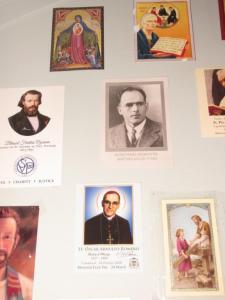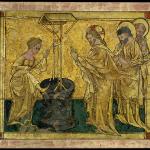Part I
Part II
Part III
Part IV-1
Despite the tremendous importance that the conversion of Constantine had for the Roman Empire, it seems that his story was often put to use to convince other rulers throughout the nations to convert to Christianity. It was believed that if a king converted, his people would follow. “To cite Constantine as an example of a ruler whose fortune decidedly turned for the better after his conversion offered clear advantages to the Roman Church in its attempt to convert pagan and barbarian rulers.“[1] Yet, his story was well known by the people, especially as his legend was told and retold throughout the centuries. With his mother, his feast day in Byzantium was to be placed upon May 21st. Even when his story was not used to create new converts, it was used, like other stories told about the saints, to help encourage a healthy Christian worldview so that Christians would not have their sense of reality challenged, and therefore, would have no reason to leave their faith.
Significant to the Constantinian legend is the way Constantine relates himself to the Church in it. First, as we have seen, Constantine placed himself into the hands of Pope Silvester – showing, in comparison, the superiority of religious rulers over the secular. By humbly bowing himself to Silvester, and pleading for baptism, this gave Silvester a great amount of authority over him. However, this is in itself not enough. While it could be acknowledged that Silvester held some control over the spiritual welfare of the emperor, that did not completely show the state to be under the complete guidance of the Church. Thus there developed, not out of any need for falsifying history but out of misunderstanding of history, the idea of the “Donation of Constantine.” From the words placed into Constantine’s mouth, we can get a glimpse of the cultural attitude of the time in which the legend developed:
Hence, in order that the pontifical majesty may not grow cheap, but may also be decorated with the power of glory, and more richly than the dignity of earthly dominion: behold, not only our palace, as was previously stated, but also the city of Rome and all the provinces of the whole of Italy and the western regions, their districts and cities, we grant and relinquish to that aforesaid pontiff of ours Silvester the universal pope […] and we grant that they shall remain under the jurisdiction of the sacred church of Rome.[2]
By having Constantine put Rome and all the western provinces under the authority of the Papacy, it is as if he were telling the world that not only does the Pope hold religious authority, but secular power as well. The “two swords” of the Pope meant that secular rulers were to see the Pope as an heir and successor to Constantine. When dealing with him, they were to acknowledge the Pope not only in his religious garb, but also as a secular ruler, and that they should submit to his authority as they would have had to submit to the authority of the Roman Empire. If they did so, then the full benefits of the new faith would also be theirs, even as it was with Constantine. Thus, the political motivation behind the religious legends of Constantine cannot be ignored, and indeed, went hand in hand with their religious implications.
In contrast to the political significance of the legends surrounding Constantine, Ashoka’s legends were aimed at the general populace and not just to secular authorities. Yes, he was a Buddhist king, and that held a great amount of significance, but what did that mean for the general populace (especially in a time or place where Buddhism held little to no political authority)? What was important was how the legend exemplified Buddhist beliefs and practices, and encouraged others to imitate Ashoka’s exemplary activities. Within Buddhism, moral stories that were based upon the life and history of the Buddha (either as Siddhartha or in any of his former lives), jakata stories, had as counterparts other moral stories or legends, avadana stories, which had the same function but were told about other famous Buddhist saints other than the Buddha. John Strong, writing about the significance of avadanas (of which the Asokavadnaa is one), says, “An avadana is a narrative of the religious deeds of an individual and is primarily intended to illustrate the workings of karma and the values of faith and devotion. It can be moralistic in tone but at the same time there is no denying that it has a certain entertainment value.“[3]
The Ashoka legends were told, as with other such stories, by wandering monastic preachers, looking to show how the life of Ashoka, a famous Buddhist monarch, could be used to encourage Buddhist piety. Interestingly enough, like the legends of Constantine where it was shown that Constantine gave the authority of the city of Rome and all the Western provinces of the empire to the Pope, we can see something similar in the legends of Ashoka.
Throughout his life, Ashoka gave a great amount of resources and treasures to the Buddhist Sangha. His devotion grew so much that he wanted to give to the Sangha at least an equal amount of wealth as the householder Anathapindada, of whom it was said had given more money than anyone else the Buddhist faith.[4] Ashoka’s ministers, learning about this, feared what would happen to the empire: “the power of kings lies in their state treasury.“[5] Because Ashoka was growing old, his ministers were able to restrict Ashoka’s access to the state treasury. While Ashoka had given a great amount of it away to the Sangha, he had not become Anathapindada’s equal. When he no longer had access to his own coffers, Ashoka continued to give all that he did have to the Sangha, becoming a virtual pauper even though he was king. At last, he only possessed half of a myrobalan fruit, and even that he gave to the Sangha. The elder of the Sangha was pleased, and cried out in joy about what Ashoka had done:
Today this lord of the earth,
his sovereignty stolen by his servants,
presents the gift of just half a myrobalan,
as though reproving the common folk
whose hearts are puffed up
with a passion for enjoying great splendor.[6]
That is, Ashoka, having himself become a pauper, showed that anyone, rich or poor, could find something to give to benefit the Sangha. To the rich, they could imitate the greatness of Ashoka when he was in full possession of his wealth; to the poor, they could look at him as an example of what they, too, could do, since everyone has something they can give.[7] At last, at the point of death, Ashoka asked his prime minister who it was that was lord of the earth, and his prime minister said that he was. With his last breath then said that all of the earth, except the treasury of the empire which he no longer controlled, was to be given to the Sangha. His ministers, seeing what was done, bought the earth back from the Sangha, and the cost of it, when paid in full, covered what was needed to make Ashoka the equal of Anathapindada. Thus, like Constantine, Ashoka could be said to have given to the Sangha all that he had. Yet, unlike the political ramifications of the donation of Constantine, the donation of Ashoka was entirely monetary, and, as we have seen, showed he was capable of being imitated by all.
Footnotes
[1] Samuel Lieu, “From History to Legend and Legend to History: The Medieval and Byzantine Transformation of Constantine’s Vitae” in Constantine: History, Historiography and Legend, Samuel N. C. Lieu and Dominic Montserrat eds. (New York: Routledge, 1998), 136.
[2] Mark Edwards, Constantine and Christendom, 112-13.
[3] John S. Strong, The Legend of King Asoka, 22.
[4] See Ibid., 287.
[5] Ibid., 288.
[6] Ibid., 291.
[7] John Strong discusses this point very well. “In his reduced straits, at the end of his life, Asoka is seen as no different from any ordinary layperson, and his offering to the sangha becomes a model for even the most destitute of Buddhists. Who, after all, cannot afford to give a myrobalan?” Ibid., 100.
















